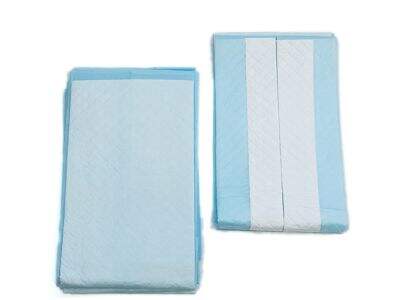ناتوانی در کنترل ادرار یا مدفوع برخی از افراد — هرچند جوان یا سالمند — به آن معنی است که نمیتوانند از ادرار یا مدفوع خود جلوگیری کنند. این بدان معناست که ممکن است به طور غیرعمد ادرار را ترشح کنند یا وقتی نیاز دارند، مشکل پیدا کردن茅茅 حمام داشته باشند. ناتوانی در کنترل ادرار ممکن است برای بسیاری از افراد بارگذار باشد و زندگی روزمره آنها را از دوستانهترین جنبهها نیز تحت تأثیر قرار دهد. شاید این موضوع باعث شود که احساس خجالت یا ناراحتی در موقعیتهای اجتماعی یا حتی در خانه داشته باشند. به علت این چالشها، ANPA ارائه میدهد پد زیرین برای ناتوانی مثانه . این لوازم درمانی کمک میکند تا افراد احساس امنیت، راحتی و محافظت کنند و بتوانند بدون هیچ نگرانی در زندگی روزمره خود عمل کنند.
چگونه باید لوازم ناتوانی در کنترل ادرار را به درستی استفاده کرد؟
پد های مختلف از ANPA برای مردان و زنان. آنها خوب برازش دارند و می توانند به طور مخفی زیر لباس مثل شلوار داخلی عادی پوشیده شوند. اهمیت دارد که روش صحیح استفاده از این پد ها را بدانید. اول اینکه، حتماً پد ها را به طور منظم جایگزین کنید تا تمیزی و راحتی را حفظ کنید. بله، حتماً دست های خود را قبل و بعد از جایگزینی پد ها شسته باشید. این کار جلوی رسیدن باکتری ها می گیرد. از این موضوع که به چه صورتی پد ها سؤال می کنند آگاه باشید. معمولاً، پادهای یکبار مصرف برای درمان بیاختیاری ادرار نیاز به تعویض هر ۲ تا ۴ ساعت یکبار دارند. زمان بستگی به میزان استفاده شما از آنها و مقدار مایعی که می توانند جذب کنند دارد.
نقاط مهم و غیرمهم استفاده از پد های ناتوانی ادراری
هنگامی که در مورد پد های ناتوانی ادراری حرف می شود، نکات ساده ای که باید انجام داد یا نداشت، می توانند کمک شما کنند تا از محصول کیفیت بالای ناتوانی ادراری بهره ورتر شوید. اینجا چند یادآوری برای ذهن داشتن است:
لطفاً توجه داشته باشید که پادهای مناسب به نظر شما از لحاظ اندازه و ظرفیت جذب را استفاده کنید. انتخاب اندازه و ظرفیت جذب مناسب میتواند کمک کند تا جریانات را کاهش دهد و شما طولانیتر راحت بوده و احساس آسایش بیشتری داشته باشید.
از استفاده از پادهای خیلی کوچک یا خیلی نازک جلوگیری کنید. اگر یک پاد خیلی کوچک باشد، ممکن است مقدار کافی مایع را جذب نکند که این موضوع موجب جریانات و عدم راحتی میشود.
پادها را با لباس زیر مناسب اندازه استفاده کنید. پادها را ثابت نگه دارید و از حرکت آنها جلوگیری کنید.
از لباسهای بسیار چسبیده که ممکن است پوست شما را تحریک کنند، جلوگیری کنید. اما لباس کردن لباسهای گشاد میتواند کمک کند تا تمام پادها در محل خود ثابت بمانند.
چگونه با استفاده از پادهای ناتوانی ادراری تمیز بمانید؟
اول از همه، اینکه واقعیت بسیار مهم است. همچنین، آنها میتوانند ادرار، مدفوع و سایر مایعات را نگهداری کنند، بنابراین حفظ بهداشت خوب کلیدی است. همیشه قبل از تغییر پد ناتوانی ادراری دستها را شسته و تمیز کنید. این کار کمک میکند تا باکتریها را دور نگه دارید. سپس، پس از تغییر پد، دستها را دوباره شسته و تمیز کنید. مطمئن شوید که پدهای مصرفشده را به درستی حذف کنید توسط قرار دادن آنها در کیسه زباله. همچنین، استفاده از صابون نرم و آب برای تمیز کردن خودتان یک ایده خوب است. عملکرد واقعی اهمیت دارد زیرا از بوی بد جلوگیری میکند و باکتریها را از رشد کم میکند زیرا باعث ایجاد تحریک پوست و عفونت میشود.
چگونه باید لوازم ناتوانی در کنترل ادرار را به درستی استفاده کرد؟
اما حفظ بهداشت بالا، راحتی و احترام، نیازمند استفاده از پد ناتوانی ادراری است. ANPA انواع مختلفی از پد ناتوانی ادراری دارد که نیازهای فردی را برآورده میکند. ادامه مطلب را برای دریافت نکاتی در مورد استفاده از این پدها بخوانید:
آنها باید محکم ولی راحت بنشیند و احساس پوشیدن لباسوند داخلی عادی را بدهد بدون احساس پوشیدن لوازم بچگی. منتظر شوید که به اندازه کافی پوشش داشته باشند تا شما را ایمن و خشک نگه دارند.
میخواهید به طور منظم پد را عوض کنید. جلوگیری از فیلتر شدن و خشک بودن پوست اهمیت دارد، بنابراین باید به طور مکرر پد را عوض کنید. این پد بی اختیاری یکبار مصرف شما را در طول روز آرامش و اعتماد به نفس حس زده خواهد کرد.
(هنگام تمیز کردن، خوب شستشو کنید و سپس لایه نازکی از کرم محافظ رطوبت بگذارید.) این کرم کمک میکند تا پوست شما از تحریک محافظت شود، که ممکن است اگر پد با شدت به پوست شما بخورد، اتفاق بیفتد.
بهداشت مناسب را حفظ کنید. توجه: همواره دستها را قبل و بعد از عوض کردن پدها شستشو دهید.
استفاده از موهههای بزرگسالان: نکات و ترفندها
استفاده از میزبانهای ناتنیدگی چندان سخت نیست، به ویژه برای کاربران جوانتر. اما اگر از این تیپهای مفید استفاده کنید، استفاده از میزبانها میتواند آسانتر باشد و همچنان پاک، راحت و با احترام باشد. برخی از نکات مهمی که باید در نظر داشته باشید عبارتند از:
لباس گشاد پوشید. لباس گشاد پوشیدن میتواند به حمایت از میزبان کمک کند و از اصطکاک با پوست شما جلوگیری کند. لباس تنگ هم میتواند مشکل باشد، زیرا موجب عدم راحتی و دشوار شدن نگهداری میزبان میشود.
میزبان مناسب استفاده کنید. مطمئن شوید میزبانی را انتخاب کنید که دقیقاً به نیازهای شما مناسب باشد. این کار کمک میکند تا احساس امنیت و راحتی داشته باشید.
قبل از اینکه میزبانها خیلی پر شوند، جایگزین آنها کنید. نمیخواهید آنها را طولانیتر از لازم بپوشید، لک شوند و پوست شما سالم بماند.
ممکن است میزبانهای دارای تب و لاینر آنها را امتحان کنید. این میتواند کمک کند تا میزبان ثابت بماند و در طول روز شما حرکت نکند.
پس از برداشتن پد یا لاینر استفاده شده، خوب میپاشید. قبل از قرار دادن پد جدید، خود را به طور کامل با فوتبال مرطوب یا مسحوق مرطوب تمیز کنید. این کار موجب میشود که هرچیزی تازه و تمیز بماند.
بهداشت باید اولویت اول باشد. البته، دست خود را قبل و بعد از تغییر پد شستشو دهید. انجام این کار ساده، شما و محیط شما را تمیزتر میکند.
بنابراین، در خلاصه، استفاده از پد درمانی برای بسیاری از افرادی که تحت مخمل میزاندرانی دارند، نعمةای بوده است. وقتی از پد استفاده میکنید، باید آنها را با گامهای صحیح، نبایدها و بایدها، تمیزی، راهنماییها و نکات استفاده کنید. این روشها کمک میکند تا تحریک پوست را حداقل کنید و عفونتها را جلوگیری کنید که میتواند منجر به مسائل جدی شود. ANPA بهبود کیفیت زندگی روزمره افرادی که با میزاندرانی مقابله میکنند را به عنوان اصلی خود در نظر میگیرد.

 EN
EN
 AR
AR
 BG
BG
 HR
HR
 DA
DA
 NL
NL
 FI
FI
 FR
FR
 DE
DE
 EL
EL
 HI
HI
 IT
IT
 JA
JA
 KO
KO
 NO
NO
 PL
PL
 PT
PT
 RO
RO
 RU
RU
 ES
ES
 SV
SV
 CA
CA
 TL
TL
 IW
IW
 ID
ID
 LV
LV
 LT
LT
 SR
SR
 SK
SK
 VI
VI
 HU
HU
 MT
MT
 TH
TH
 FA
FA
 AF
AF
 GA
GA
 HY
HY
 AZ
AZ
 KA
KA
